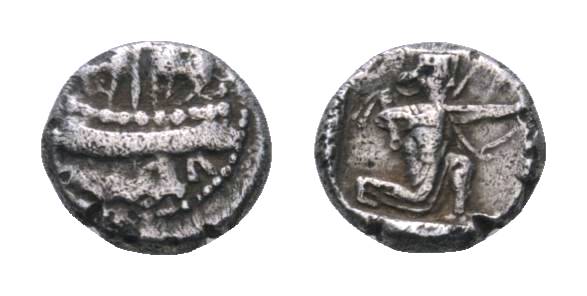Sidon, silver,16th shekels (435-425 BCE)
From SILVER
435 BCE - 425 BCE Silver 948 kg
Description
| ObverseInscription or printing placed on the obverse.: | Galley with sale right |
| ReverseInscription or printing placed on the reverse.: | Persian king kneeling right and firing bow |
Mint and issuing power
| MintIdentifies the place of manufacture or issue of a numismatic object.: | Sidon | Ancient regionAncient region.: | Phoenicia | Modern countryModern country: Lebanon | AuthorityIdentifies the issuing power. The authority can be "pretended" when the name or the portrait of X is on the coin but he/she was not the issuing power. It can also be "uncertain" when there is no mention of X on the coin but he/she was the issuing power according to the historical sources: | Persian Empire |
Chronology
| FromIdentifies the initial date in a range assigned in a numismatic context. | 435 BCE | toIdentifies the final date in a range assigned in a numismatic context.. | 425 BCE | PeriodTime period of the numismatic object.: Classical 480-323 BC |
Physical description
| MetalThe physical material (usually metal) from which an object is made.: | Silver |
Median weightMedian of the weights of numismatic objects (in grams). in grams | 0.85 | DenominationTerm indicating the value of a numismatic object. Examples: tetradrachm, chalkous, denarius.: | 16th shekel | StandardStandard.: | Persian |
Image

S1897 Sidon 16th shekels II.4.jpg [1]
References
| Die study referencePublication of the study: | Elayi - Elayi 20041Elayi - Elayi 2004, p. 125-130, n° 776-803 (Group I.4) | ||
| Coin series referenceReference to coin series study: | Sear II2Sear II, n° 5929, HGC 103HGC 10, n° 217 | ||
| Coin series web referenceCoin series web references: | |||
Obverse dies distribution
Reverse dies distribution
no distribution is available
Quantification
| Number of obversesNumber of obverse dies. ᵖ (o) | 15 | Number of singletons (o1)The number of singleton coins. ᵖ | 11 |
| Number of reverse diesNumber of reverse dies. (r) | 16 | Number of coinsNumber of coins. (n) | 19 |
| Coins per obverse dieNumber of coins per obverse die. (n/o) | 1.27 | Coins per reverse dieNumber of coins per reverse die. (n/r) | 1.19 |
| Reverse per obverse ratioRatio of obverse dies divided by reverse dies. (r/o) | 1.07 | Percentage of singletons (o1)number of coins (n) divided by the number of singletons (o1) ᵖ | 73.33 % |
| Original number of dies (O) (Carter 1983 formula)The estimation of the number of coins according to Carter 1983 ᵖ | 55.76 | Coins struck if 20,000 as average productivity per dieCoins made if the average productivity for obverses (according to Carter) is 20,000. ᵖ | 1,115,200 |
| Original number of dies (O) (Esty 2011 formula)The estimation of the number of coins according to the singleton formula in Esty 2011 ᵖ (O) | 71.25 | Survival rate if 20,000 as average productivity per dieSurvival rate if average productivity is 20,000. ᵖ | 0.00002 |
| Coverage (o = % of O) (Esty 1984 formula)Esty 1984 - coverage (% of O) ᵖ (o = % of O) | 42.11% | Die productivity if survival rate 1/2,000Average productivity if survival rate is 1/2,000. ᵖ | 681.49 |
| Weight of silver (in kg) if 20,000 coins per die (O = Carter formula)Carter 1983 * Median weight * 20000 (*10 if gold or electrum) ᵖ | 948 kg <br /> 948 kg | Die productivity if survival rate 1/5,000Average productivity if survival rate is 1/5,000. ᵖ | 1,703.73 |
Remarks